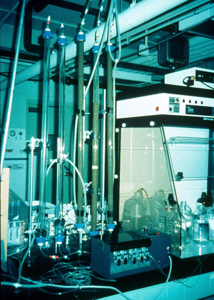.gif) VIARTIS � |
||||||
|
PARKINSON'S DISEASE |
||||||
| � � |
||||||
|
� � � � |
PARKINSON'S DISEASE NEWS � |
� � � � � � � � � � � � � � � |
||||
|
NOVEMBER 2011 ������������������ ������������������������������������������������������������������������������������������������������������������������������ 19th November 2011 - New research SMOKING REDUCES THE RISK OF PARKINSON'S DISEASE Fukuoka Igaku Zasshi [2011] 102 (8) : 254-265 (Kiyohara C, Kusuhara S.)� Complete abstract Movement Disorders [2011] Nov 16 [Epub ahead of print] (Searles Nielsen S, Gallagher LG, Lundin JI, Longstreth WT Jr, Smith-Weller T, Franklin GM, Swanson PD, Checkoway H.) Complete abstract
Tobacco smoke contains chemicals that are MAO inhibitors. MAO inhibitors are a type of drug (such as Selegiline and Rasagiline) used commonly in Parkinson's Disease. MAO inhibitors affect Parkinson's Disease by maintaining dopamine levels. The main drug in tobacco, which is nicotine, is heavily involved in the activity of acetylcholine, a chemical in the body that affects the activity of dopamine. In order to refer to this article on its own click here.� � 17th November 2011 - New research TRICHLOROETHYLENE MULTIPLIES THE RISK OF PARKINSON'S DISEASE Annals of Neurology [2011] Nov 14 [Epub ahead of print] (S.M.Goldman, P.J.Quinlan, G.W.Ross, C.Marras, C.Meng, G.S.Bhudhikanok, K.Comyns, M.Korell, A.R.Chade, M.Kasten, B.Priestley, K.L.Chou, H.H.Fernandez, F.Cambi, J.W.Langston, C.M.Tanner) Complete abstract
A previous study showed that workers with workstations adjacent to the source of Trichloroethylene and who were subjected to chronic inhalation and dermal exposure from handling Trichloroethylene soaked metal parts all had Parkinson's disease. Lesser chronic respiratory exposure to Trichloroethylene led to many features of Parkinsonism. For more information go to the Complete abstract. In order to refer to this article on its own click here.� � 14th November 2011 - New blog THE DOPAMINE CHRONICLES
� 5th Novem ber 2011 - New researchNEUROPATHY IS COMMON IN PARKINSON'S DISEASENeurology [2011] Nov 2� �[Epub ahead of print] (Y.A.Rajabally, J.Martey) �Complete abstract
Neuropathy has been found to be nearly seven times more prevalent in
Parkinson's Disease. Neuropathy is the
malfunction of nerves throughout the body. Neuropathy can cause a
pins-and-needles sensation, numbness, burning pain, loss of vibration
sense, and a loss of position sense, which is not knowing where the arms
and legs are. Walking and even standing can become unsteady. The effects
of neuropathy can progress to far more widespread
�
��
|
||||||
| � | ||||||
.gif) |
||||||
| � | ||||||
| �2006-2011 Viartis | ||||||
| � | ||||||
| [email protected]� | ||||||
 The risk of developing Parkinson's Disease has been found to be far lower in
people that smoke. Current smokers reduce the risk of developing Parkinson's
Disease down to 31%. Those people that have ever been smokers reduce the risk
down to 55%. Former smokers reduce the risk to 72%. The risk of Parkinson's
Disease therefore effectively increases over time if somebody gives up smoking.
These results were obtained by assessing all the possible studies concerning
smoking and Parkinson's Disease. Even the risk for passive smokers was reduced
to only 34%. What the results do not show is whether those
people inclined to be smokers are for some reason less likely to develop
Parkinson's Disease, or if smoking has an effect on the biochemistry involved in
Parkinson's Disease.
The risk of developing Parkinson's Disease has been found to be far lower in
people that smoke. Current smokers reduce the risk of developing Parkinson's
Disease down to 31%. Those people that have ever been smokers reduce the risk
down to 55%. Former smokers reduce the risk to 72%. The risk of Parkinson's
Disease therefore effectively increases over time if somebody gives up smoking.
These results were obtained by assessing all the possible studies concerning
smoking and Parkinson's Disease. Even the risk for passive smokers was reduced
to only 34%. What the results do not show is whether those
people inclined to be smokers are for some reason less likely to develop
Parkinson's Disease, or if smoking has an effect on the biochemistry involved in
Parkinson's Disease.  Exposure
to the
solvent Trichloroethylene has been found to
multiply the risk of Parkinson's Disease by six times.
Results were similar for
estimates of exposure duration and cumulative lifetime exposure.
Trichloroethylene is a solvent that is used extensively in industry and the
military and is a common environmental contaminant. It has been used to extract
vegetable oils, in coffee decaffeination, and in the preparation of flavouring
extracts from hops
and spices. Much of its use has been banned because
of toxicity. Trichloroethylene is the most common organic contaminant in
groundwater, and so can cause toxicity via the water supply. Around 30% of U.S.
water supplies are contaminated by Trichloroethylene. For more information go to
Exposure
to the
solvent Trichloroethylene has been found to
multiply the risk of Parkinson's Disease by six times.
Results were similar for
estimates of exposure duration and cumulative lifetime exposure.
Trichloroethylene is a solvent that is used extensively in industry and the
military and is a common environmental contaminant. It has been used to extract
vegetable oils, in coffee decaffeination, and in the preparation of flavouring
extracts from hops
and spices. Much of its use has been banned because
of toxicity. Trichloroethylene is the most common organic contaminant in
groundwater, and so can cause toxicity via the water supply. Around 30% of U.S.
water supplies are contaminated by Trichloroethylene. For more information go to
 The
Dopamine Chronicles is the new Parkinson's Disease blog of cartoonist Martin Bee. His blog
specialises in Parkinson's Disease cartoons. In the words of Martin Bee "Any of you diagnosed with this
disease probably can relate to the reaction. The Dopamine Chronicles is all
about me continuing my art, my toons and so on. So I decided to do (almost) a
cartoon a day about Parkinson�s and me." Martin Bee is a 60 year old
Vietnam Veteran who was a Navy Corpsman stationed with the 1st Marine Division
whilst he was in Vietnam.
After leaving the Navy, he graduated in Art and then worked in design and
illustration. Despite being diagnosed with Parkinson's Disease, which included a
shaking right hand, he could still draw. Although Parkinson's Disease hindered
his drawing technique, he altered the techniques he used in order to overcome the problems it
caused him.� For The Dopamine Chronicles web site
The
Dopamine Chronicles is the new Parkinson's Disease blog of cartoonist Martin Bee. His blog
specialises in Parkinson's Disease cartoons. In the words of Martin Bee "Any of you diagnosed with this
disease probably can relate to the reaction. The Dopamine Chronicles is all
about me continuing my art, my toons and so on. So I decided to do (almost) a
cartoon a day about Parkinson�s and me." Martin Bee is a 60 year old
Vietnam Veteran who was a Navy Corpsman stationed with the 1st Marine Division
whilst he was in Vietnam.
After leaving the Navy, he graduated in Art and then worked in design and
illustration. Despite being diagnosed with Parkinson's Disease, which included a
shaking right hand, he could still draw. Although Parkinson's Disease hindered
his drawing technique, he altered the techniques he used in order to overcome the problems it
caused him.� For The Dopamine Chronicles web site
 and
serious symptoms. For more information go to
and
serious symptoms. For more information go to